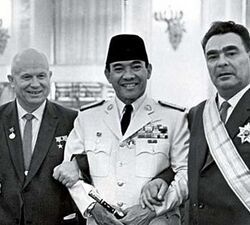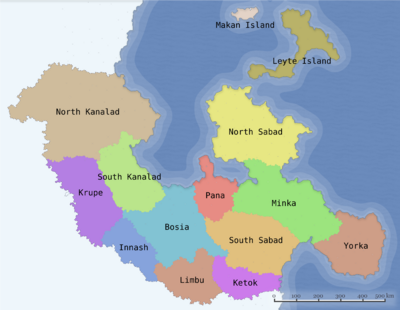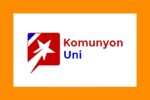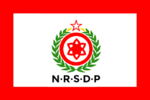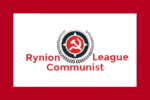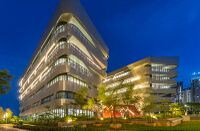Rynion
People's Republic of Rynion Porma Reispaublik Rynaion | |
|---|---|
| Motto: "We Who Were Nothing Shall be All!" | |
| Anthem: "Red Flag" | |
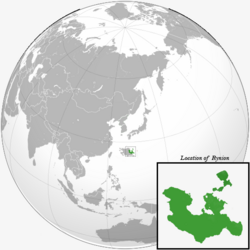 Location of Rynion | |
| Capital | Landamac |
| Official languages | English and Rynian |
| Recognised national languages | English,Rynian,Kician,and Canaris |
| Recognised regional languages | Tagalog,Malay,+20 native languages |
| Demonym(s) | Rynionian (Single) Rynionians (Plural) |
| Government | Dominant-Party Democratic Socialist Republic |
| Legislature | National People's Assembly |
| Provisional People's Assembly | |
| Establishment History | |
• Rynai Tribes | 4500 BC |
• Nyancipe Empire | 13th Century |
• British Colonization | 1817 |
• Declaration of Independence | March 3rd 1919 |
• Japanese invasion | February 1942 |
• FSN Annexation of Rynion | December 18th 1951 |
• Independence from FSN | August 5th 1980 |
| Population | |
• 2020 estimate | 86 Million |
| GDP (nominal) | 2020 estimate |
• Total | 189 Trillion USD |
| Gini | 25.3 low |
| HDI | 0.750 high |
| Currency | Rynionian Ruan (RYR) |
| Time zone | +10 GMT |
| Date format | dd-mm-yyyy |
| Driving side | left |
| Internet TLD | .ry |
Rynion, officially The People's Republic of Rynion is a nation in Nyancipe Island, Southeast Asia, located between Taiwan and the Pacific Ocean. Rynion is a Dominant-Party Democratic Socialist Republic with a semi-elected legislature and has a president as the head of state. It has 15 provinces which operates under the supervision of the state. The country shares land borders with Luchtvart,Ameno, and Canar.Despite its large population and densely populated regions, Rynion has vast areas of wilderness that support a high level of biodiversity.
The history of Rynion has been influenced by foreign powers drawn to its natural resources and soil fertility. It has been an important region for trade since at least the 13th century when the Nyancipe Empire traded with entities from mainland China and Asia. Muslim traders and Sufi scholars brought Islam. The British Empire conquered Nyancipe and brought Christianity. Rynion officially gained independence after a partition drafted by the British in 1919. Rynion was absorbed by the Socialist Federation of Nyancipe in 1950. The SFN forged strong alliances with the Soviet Union and nearby communist states until its collapse in 1980.
Rynion consists of three main native ethnic and linguistic groups, with the largest—and politically dominant—ethnic group being the Rynaians. A shared identity has developed, defined by a national language, ethnic similiarity, and a history of colonialism and rebellion against it. Rynion's national motto,"We Who Were Nothing Shall Be All", articulates the spirit of their people who oppose against frequent intervention by foreign powers that shape the country throughout its history . The economy is driven entirely by a combination of government and state-owned industry, with private enterprise illegal. The industrial sector is dominated by the Information Technology industry, with significant contributions from Tourism, Book Publishing, and Beef-Based Agriculture. Incomes are distributed extremely evenly with practically no difference between the richest and poorest citizens. The country has abundant natural resources like oil and natural gas, tin, copper, and gold. Agriculture mainly produces oats, palm oil, rice, tea, and coffee. Rynion major trading partners are Japan, South Korea, ASEAN Countries Russia,and China. Rynion is a member of several multilateral organisations, including the UN, WTO, Asia-Pacific Economic Cooperation, and East Asia Summit.
Etymology
The word "Rynion" derives from the Welsh word for hulled oats. The term was used by British settlers in the mid-18th century to designate the most fertile part of Nyancipe Island and its native tribes on the area referred to as "Rynionians" or the "Rynai Tribe". The word "Rynion" wasn’t widely used until the British divided the island into 7 republics and one of them was named Rynion. During the SFN, Rynion was widely known by the rest of the world as the agricultural powerhouse of the SFN.
However, the island itself was named after the longest river in Asia by Chinese explorers. It was named "Nansip" but later called "Nyancipe" due to the different language between them and the native islanders. "Nyancipe" was widely known during the Nyancipe Empire.
History
Early History
Humans arrived from Asia through a landbridge approximately between 60,000 and 100,000 years ago. Skeletal remains suggests that Homo Sapiens and Homo Erectus coexist in Nyancipe. Around 5000 BC, inhabitants of the island developed agriculture. The perfect climate of the island makes it ideal for the cultivation of various plants including wheat, corn, and oats
Tribal Eras
As the inhabitants of the Island develop, many tribal communities emerge and rule small portions of land scattered throughout the island. The Kicens emerge on the eastern parts of Nyancipe, while Rynians to the west and Canarians to the south. Tribal communities typically consist of a few houses, a large farmland, and storage huts. Although the full extents of their territories are unknown, archeological evidence from 4500 BC suggests that the current territories of Macra, Kicen, and Luchtvart are far less populous than any other part of the island. Modern-day Rynion was home to the Rynians which were the largest tribal community in the area.
Communities make it easier for technology to advance. In 3200 BC, they began to develop sophisticated writing systems and advanced stone tools and weapons. Wars are fought frequently by tribal communities over food and territory claiming dozens of lives.
Unification and Formation of the Nyancipe Empire
From the 13th century until the 17th century, the island was unified under the Nyancipe Empire. The Nyancipe Empire was formed after a massive 10-year war between three large tribal communities of Canari, Rynai, and Kicens that claimed the lives of almost 7.000 people. In the early years of the war, the Canarians dominated southern Nyancipe after a large battle with Rynai claiming 2.000 lives which severely weakens the Canarians. Rynaians and Kicens fought for territories on modern day Ameno. After 4 years of stalemate, Rynaians and Kicens agreed on a peace treaty and merged their territory. The joint Kicen-Rynai tribes fought back against the Canarians and after a decisive victory at the battle of Harkuz, the Canarians offered to join the alliance and establish a newly unified empire with the capital in Kamya.
The Nyancipe trades with various empires across the globe from the Ottoman Empire to the Qing Dynasty and also many other kingdoms in Asia. Most of their exports are agricultural products, fish and minerals. Influence from this era can be seen in the modern day as religion, predominantly Islam and Confucianism, as well as languages like Arabic and Malay. Technological advancements flourished in the empire with significant advancements in agricultural,mining,seafairing,etc.
Fall of Nyancipe Empire and British Colonization
The British Empire arrived in Nyancipe in the late 17th century. Britain declares war against the Nyancipe Empire in the early 18th century. The war was fought for 4 years, hundreds of thousands of Nyancipians died which severely reduced the population and as much as 1.000 British soldiers. The war finally ended with the collapse of the Nyancipe Empire in 1807. Britain began colonizing and settling on the island. They enslaved the locals into working on fields and mines throughout the island. Millions of Nyancipian suffered under colonial rule. Britain’s colonization of Nyancipe brought Christianity and English to the island.
World War 1 and Nyancipian Partition
After WW1, The British Empire's economy was nearing a collapse. They began drawing plans of a Nyancipian Partition. They divided the island into 7 independent republics according to the different ethnic groups; Kicen, Luchtvart, Dovia, Macra, Rynion, Ameno, and Kanar. They implemented the plan on March 3rd 1919 which resulted in a mass displacement of people moving to their ethnic states. The move went smoothly however unlike the Britihs had expected. A strong sense of nationalism grew upon the native islanders of which the desire to having their own homelands were finally fulfilled.
The newly founded Republic of Rynion drafted its constitution on July 17th and came into effect a few months later in October. The first presidential election on New Year’s Eve 1920 elected Karzai Mik as President. The economy was heavily depended on agriculture with the agriculutral sector acocunting for 75% of the entire state economy.
Japanese Invasion during World War 2
In February 1942, Imperial Japan launched a full-scale invasion on Nyancipe. Rynion and its allies (6 other countries on the island) formed a Joint Military called the Markidan, consisting of 60.000 troops to counter the Japanese invasion. The first campaign against the Japanese took place in the ports of Northern Luchtvart and Kicen of which thousands of Japanese and Markidan casualties. Japanese forces came out victorious after a month of fighting. Japanese forces steam-rolled through Nyancipe taking large parts of the Island within 3 months. The last Markidan forces were surrounded in Rynion and surrendered on November 21st, 1942. Nyancipe was under Japanese control until 1945.
SFN and the Cold War
Seeing the success of the Soviet Union during WW2, Luchtvart, Dovia, Macra, and Kicen merged and formed the Socialist Federation of Nyancipe (SFN) on February 6th, 1949. For the next 10 months, war broke out between the new SFN and the surrounding states on the island including Rynion. The war resulted in Socialist victory and the whole island fell into socialism. In 18th of December, the Socialist Party of Nyancipe (SPN) was founded by Akdu Kivan. The socialist party started purging political opposition in February 1950. All who dare to speak out against their rule was executed, deported, or imprisoned. The collectivization of farmlands and industries started in June the same year. Millions of people are forced to work in fields and factories all across the island with minimum rations and pay. By 1952, all industries within the Republics of the SFN become state-owned.
During 1953 – 1962, the SFN establish close ties with the Soviet Union and China. Soviet intelligence officers are often stationed in Nyancipe as a base of operations for their espionage missions in Japan, South Korea, and Southeast Asia. The Sino-Soviet split did a massive blow to the SFN's economy because much of the people depended on foreign aid,
During the height of the Vietnam War, SFN aided the North Vietnamese by supplying weapons, ammunition, and food. Although no records exist on how much aid was going into North Vietnam, experts estimate that around 10% of North Vietnamese weapons and ammunition, as well as 16% of rations, come from SFN. Soviet intervention in the Middle East and Afghanistan prompted the SFN to increase their military spending and send troops to fight alongside Soviet forces. As of 1980, SFN sends over 10.000 troops to Afghanistan and military spending accounted for 35% of the national budget.
Fall of SFN
The SFN economy was failing in the 1980s due to overspending in the military. People all across the Federation are starving and angry. With the death of Premier Heinz Ardal, his successor Karvin Lat sought to revitalize the economy by allowing private ownership of businesses and loosening regulations on free speech. The people who had been oppressed for decades took to the streets of the Federation’s capital. The Nationwide revolution against the Federation lasted from 9 June until 10 August 1983.
The revolt began as a student protest, which attracted thousands as they marched through central Harkuz to the Socialist Party Parliament building, calling out on the streets using a van with loudspeakers. A student delegation, entering the radio building to try to broadcast the students' demands, was detained. When the delegation's release was demanded by the protesters outside, they were fired upon from within the building by the Federation’s Security Police (FSP). This was the start of the revolution. As the news spread, disorder and violence erupted throughout the capital.
The revolt spread quickly across Nyancipe, and the government collapsed. Thousands organized into militias, battling the FSP. Pro-Socialist and FSP members were often executed or imprisoned, and former political prisoners were released and armed. A new temporary government formally disbanded SFN and establishes the Re-independence of the 7 republics. By 9th of August, fighting had almost stopped, and a sense of normality began to return.
Geography
Geographical Features
Rynion consists mostly of plains, which accounts for about 53% of its total area. Hills are found along the northeast as well as the south of Rynion in the provinces of Krupe, Limbu, and Innash. Plains are mostly found in the province of North Kanalad, Krupe, and Limbu. Rynion's biggest river is the Labeles river which stretches from Minka to South Sabad and into Sabayor Bay. Other well-known rivers are the Atan and Malbayaco rivers in Kanalad. Most rivers carve out valleys in the highlands, with plenty of rapids and other features associated with such topography
Rynion's waters are full of geographical features such as straits, gulfs, chasms, and bays. Rynion's northern sea, called the Rynion Sea, flows into the Gulf of Dapit through Landamac Strait as well as into the Satar Sea through the Strait of Satar.
Elevation
Altitude tends to be higher in the south and south-western parts of the country with its highest peak in Mt.Yanta measuring around 3.800 meters. Other prominent mountain includes Mount Karpi reaching altitudes of 2900 meters. One of Rynion's most notable highlands is in the province of Limbu with an average elevation of 2000 meters above sea level. Meanwhile, Rynion's deepest point is in the Rynion Sea with a depth of 1000 meters below sea level in an undersea chasm dubbed the Sarkaz's Drop.
Climate and Biomes
Rynion are dominated by wide grasslands and plains stretching from the north, center, and south of Rynion. There are also plenty of wetlands along major rivers which are prime areas for agricultural production. Temperate deciduous forests and temperate rainforests are also present. These types of forests mostly cover the eastern parts of Rynion and along the northern coastline.
Government and Politics
Government
Rynionian political system is a dominant-party system with 7 political parties. The largest and the only party that is allowed to hold high-ranking national offices are The National Rynionist Democratic Socialist Party (NRDSP). Other political parties are only allowed to hold positions as low-ranking national offices and provisional level offices. The high political freedom in the country made it possible for political parties to have millions of members.
Rynion's elections are held every 8 years to choose new members of the National People's Assembly, and every 16 years to choose a new president. (NPA. The NPA consists of 500 seats of which 60% of which are reserved for the NRDSP and the remaining 40% are contested by the 8 political parties.
The Executive Branch of Rynion is the President and Vice President. Both are elected by the people for an 8-year term. The president has a term limit of 2 times or 16 years. The presidential candidate has to be a Rynionian citizen since his/her birth, who has not willingly become a citizen in another nation, are NRDSP member, has not betrayed the nation in any way, and is physically and mentally capable of doing the job. The president has constitutional authority over the government and has the power to name and remove ministers. He or she has the right to propose bills to the NPA, discuss bills with the NPA and reach an agreement, make government regulations in accordance with the constitution, and in case of emergencies, has the power to take control of the government.
Militarily, the president holds supreme authority over the Rynionian National People's Forces. Diplomatically, the president can sign treaties, appoint ambassadors, accept ambassadors from other countries, rehabilitate prisoners, and declare peace and war. The president has the power to grant pardons but must consider the advice of the NPA. The president also has the final say over chief justice candidates.
The Legislative Branch of Rynion is the National People’s Assembly (NPA). The National People’s Assembly has 500 seats. The NPA is tasked with making laws, appointing political positions, and addressing national issues. It is headed by the Assembly President. The NPA consists of The President and Vice President, Assembly President, Governors, and elected members of political parties. The NPA held an annual meeting every October to discuss national issues and appoint new members of government.
The Judicial Branch of Rynion is the People’s Court. The People’s Court is tasked with interpreting and applying laws that have been passed by the National People's Assembly. The court also has the power to impeach high-ranking government officials for treason and other severe illegal activities.
Political Divisions
Rynion consists of 15 provinces, each with their own governors and judiciary. Governors are tasked with maintaining order at the provisional levels and reporting everything during NPA meetings. They are elected by the people of their corresponding province. The provisional government has Its own judiciary called the Provisional Court. The Provisional Court has the authority to judge or adjudicate legal disputes between parties and carry out the administration of justice in civil, criminal, and administrative matters in accordance with the rule of law. The legislature of each province is regulated by the NPA. Each governor can propose laws that will apply to their corresponding province.
The provinces in Rynion are composed of several regencies headed by a regent. They're the lowest tier political divisions in the country. Each province can have up to 25 different regencies depending on the area of the province. Regencies directly adhere to the laws on the provisional levels thus no regencies have their own legislature.
The Province of Pana has a Special Status as a result of having the nation's capital. The province is headed directly by the government, unlike many other provinces. The island province of Leyte and Makan are Special Administrative Islands (SAI). They have their own legislative body called the Special Administrative Legislatures (SAL) which is headed by a chief executive chosen by the NPA.
Political Parties
Rynionian political system is a dominant-party system with 7 political parties. The largest and the only party that is allowed to hold high-ranking and national offices are The National Rynionist Social Democratic Party (NRSDP). Other political parties are only allowed to hold positions as low-ranking national offices and provisional level offices. To exist and be approved by the government, a political party must have at least 10.000 members and at most 1 million. They must have a clear goal to exist and must adhere to the Constitution.
Below are the political parties in Rynion:
| Political Party Flag | Name of the Party | Ideology | Seats in Parliament |
|---|---|---|---|
Military
The Rynionian National People's Military (RNPM) consists of the army (RNPM-A), Navy (RNPM-Vy), and airforce (RNPM-AF). The RNPM was established after independence by mandatory military service, which continues to this day, for citizens between the age of 20-25 with men serving 4-5 years and women for 2-3 years. Conscription is based on physical and mental capability, those who cannot fulfill the requirements aren't required to be in the military. The RNPM-A consists of 200.000 active duty personnel and 20.500 more in reserves. They possess 561 military vehicles, 327 aircraft, and 264 ships and naval assets. The Army also has 145 long, medium and short-range ballistic missiles
The RNPM participates in numerous UN peacekeeping missions, most notably in Africa and The Middle East. They also take part in joint military exercises with its close allies Japan, South Korea, and Russia. Recently, a massive military exercise between the four countries was held in Russia as a show of strength against the ever-growing influence of communist China.
Foreign Relations
Rynion currently maintains over 126 diplomatic missions across the world, including 108 embassies. Rynion follows a “free and active” foreign policy seeking to play a role in regional and International affairs while staying out of conflicts and disputes. Rynion’s largest trading partners are Japan and South Korea. Rynion also maintains close relations with Russia and members of ASEAN like Indonesia and Malaysia also nations in Nyancipe Island including Dovia, Luchtvart, and Kicen. The country reestablishes diplomatic ties with the United Kingdom and Europe in 1994. Rynion has a good relation with the US.
Rynion has been a member of The United Nations since 1987. Members of Rynionian armed forces also participate in Peacekeeping missions across the world. Rynion has been a humanitarian and development aid recipient since 2003, and recently, the country has expressed interest in becoming an aid donor. The country is also a member of the Asian Cooperative Dialogue, East Asian Summit, and other international organizations.
Economy
Rynion has a centrally planned economy in which government corporations or state-owned enterprises play significant roles while the private sectors are heavily regulated and monitored. State-owned industries account for 65.17% of the economy while the other 34.83% are privately owned. The country has one of the largest economies in Nyancipe and is classified as a newly industrialized country. As of 2020, its GDP is estimated to be 4.78 trillion USD, roughly between Germany and Japan. Its industrial sector is dominated by trade from various countries, with significant contributions from agriculture, tourism, and services. Incomes are distributed quite evenly with a GINI score of 25.3. Rynion is also one of the few countries on the island that introduces universal healthcare and education.
Transport
Rynion's transportation network has been shaped overtime by its economic resources and the need to trade with other countries. It heavily relies on a national road system with a total length of…..km. The railway system is composed of…. interconnected networks spanning from….to… which are primarily dedicated to transporting raw resources. As a predominantly trade-based state, Rynion has dozens of well-developed large ports. Its largest port is located in…just…..km…of Landamac. Domestic flights are also commonplace with interconnected flight routes between the major cities.
Energy
Energy in Rynion is managed under the Ministry of Energy and Natural Resources with a policy of monitoring, controlling, and maintaining energy flow. Under this policy, energy production and consumption will be strictly controlled and monitored to ensure efficiency and sustainability. This has been proven quite successful in handling crises such as typhoons and floods during rainy seasons.
Rynion's energy consumption is .... per year with its production.... The energy makeup of Rynion is quite diverse with hydropower, wind and solar, fossil fuels, and some contributions from nuclear power. Rynion, taking advantage of its many rivers, is home to some of the largest hydroelectric dams in the region. One of them, the.... produce ...of electricity every year.
Science and Technology
The Ministry of National Innovation and Research is the governing agency responsible for the development and coordination of scientific projects. Government expenditures on research and technology account for 2.74% of the national budget. This allows Rynion to develop new technologies and innovations albeit at a slow pace. Despite having a research budget of only…billion dollars, a few notable innovations have emerged over the few years. For example, Rynion has managed to develop a new method of cultivating rice by experimenting with new rice varieties and management techniques. This proves to be a huge success as the overall production of rice increased by 7.3%.
Another notable example of Rynionian technology is the creation of a highly secured national database that contains information regarding the current state of its economy, politics, and culture. Its database is protected by the latest encryption technology and managed by skilled professionals.
Demographics
Population and Ethnicities
Rynion has a population of about 1.77 billion people and a population growth of 1.9%. Most of the population lives on the mainland. 80 million people live in the Special Province of Pana while 60 million people live either abroad or in the Special Administrative Provinces of Gyam and Makan Islands.
The Rynionian government reports that around 67% of the population are natives which mainly consists of Rynaians, Kicens, and Canaris, as well as minority natives such as Lucthvartians and Dovias. Alternatively, the ethnic groups of Rynion may be roughly divided among the Filipinos (31%), Polynesian (15%), Han Chinese (5%), Japanese (8%), and others (17%)
Nyancipian Natives are the largest ethnic group in Rynion composing 67% of the entire population. The Canarians are natives from the southern parts of Nyancipe while Kicens are from the western part. Luchtvartians and Dovias are likely to be descendants of the ones who did not want to move to their state during the partition. The Natives share a similar appearance. They also speak a similar language in terms of dialects and accents to Filipino/Tagalog.
Filipinos that are currently residing in Rynion are mostly immigrants who gained Rynionian citizenship during WW2 before the Japanese invasion. Polynesian citizens of Rynion are descendants of their ancestors who sailed to Nyancipe and settle there. Most Polynesian citizens are also immigrants. Han Chinese are mostly immigrants and/or descendants of refugees from the Chinese civil war. The Japanese are remnants of the Japanese invasion and colonization during WW2. 17% of Rynionians come from a wide range of ethnic backgrounds. There are Arabs, Bamars, Vietnamese, Austronesians, etc.
Religion
The Rynionian constitution stipulates the freedom of religion in the country. Although some of the population are religious, 75.32% of people identify themselves as "Secular Humanist" following secular humanism. Secular humanism is a philosophy or life stance that embraces human reason, secular ethics, and philosophical naturalism while specifically rejecting religious dogma, supernaturalism, and superstition as the basis of morality and decision-making. Religious tolerance is strongly encouraged and even included in the country's constitution.
Although most of the population is irreligious, about 24.68% believe in some sort of religion. 10.68% of people said that they follow Christianity, 5.73% follow Islam, 5.32% Confucianism, Hindu Buddhism, and other religions at 2.95%. Christianity is thought to have spread through the British conquest of Nyancipe and Islam through generations of descendants from Islamic merchants during the times of the Nyancipe Empire.
Education
Rynionians are required to have at least 12 years of compulsory education in which they can choose between state-run institutions, private or semi-private schools, as well as religious and international educational establishments. In addition, Rynion also has numerous higher educational institutions including the University of Rynion, the University of Minka, and Fardesto’s Institute of Technology according to QS World University Ranking. Education in Rynion is under the supervision of the Ministry of Education whose budget accounts for 5,7% percent of GDP. Enrollment rates are 96% for primary education, 90% for secondary education 90% for secondary education, 87% for tertiary education, and 73% for higher education. Rynion has a 96% literacy rate with the majority of nonliterate populations living on islands along Gyam Island.




